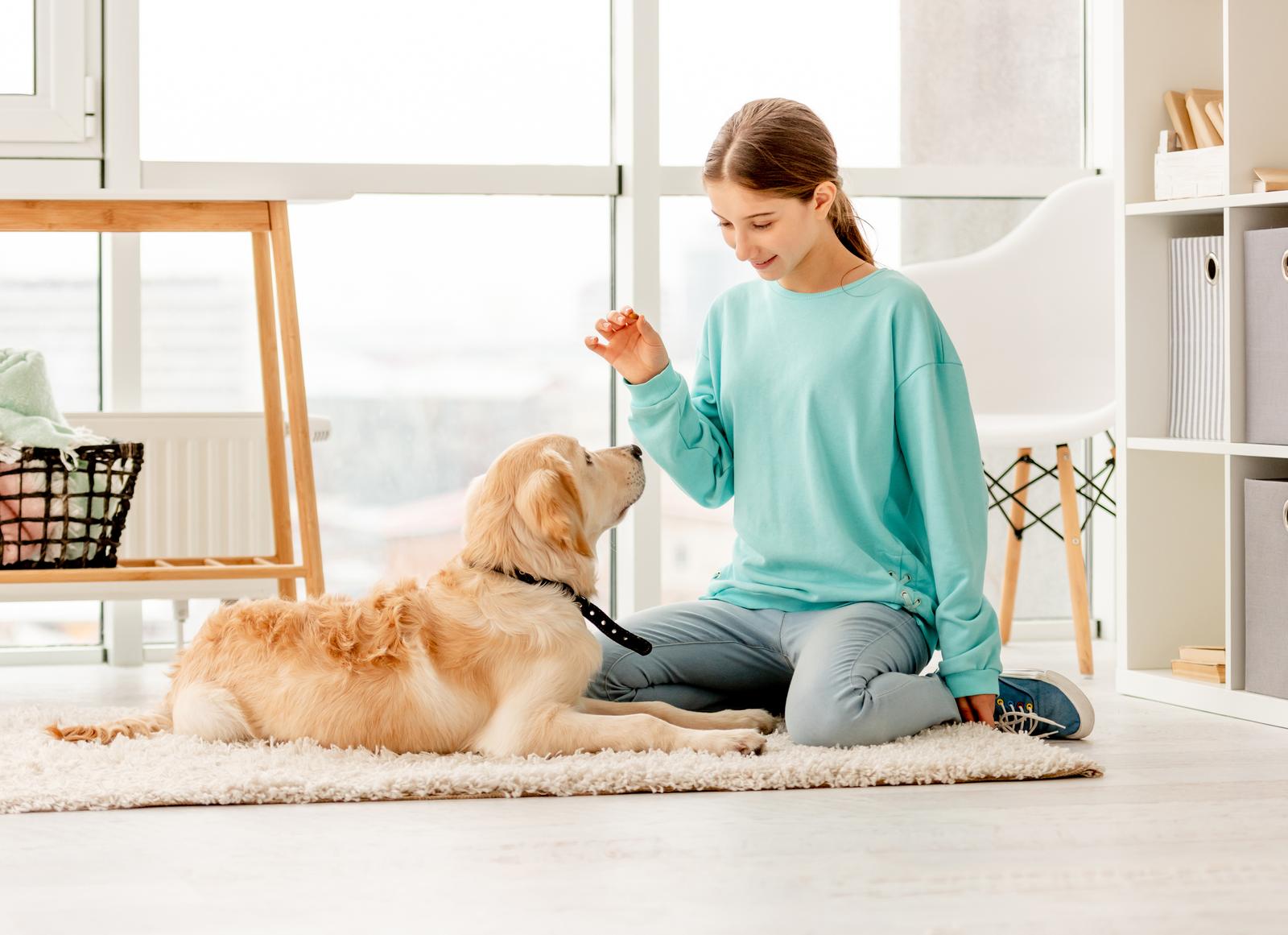FTC disclaimer. This post may contains affiliate links, and I will be compensated if you purchase through one of my links.
When it comes to training your dog, you can use many different methods. Some people prefer to use negative reinforcement, while others swear by positive reinforcement. So, what’s the best method?
Well, that depends on a number of factors. However, we believe that positive reinforcement is often the best method, especially when teaching your dog new tricks or behaviors.
Positive reinforcement is a form of operant conditioning, a type of learning that occurs as a consequence of the consequences of a behavior. In other words, it’s a way of teaching your dog that good things happen when they behave in a certain way.
For example, if you want your dog to sit, you would give them a treat when they sit down. This would be an example of positive reinforcement. The dog is being reinforced (rewarded) for sitting down, so they are more likely to do it again in the future.
Negative reinforcement, on the other hand, is when you punish your dog for bad behavior. For example, if your dog jumps up on you, you might scold or push them away.
This would be an example of negative reinforcement. The dog is being punished (reinforced) for jumping up, so they are less likely to do it again in the future.
So, which method is better?
There are pros and cons to both methods. However, we believe that positive reinforcement is often the best method, as it’s a more gentle and effective way to train your dog.
Positive reinforcement teaches your dog that good things happen when they behave in a certain way. This is a much more effective way to train your dog, as they will quickly learn that certain behaviors are rewarded.
Negative reinforcement can be quite harsh and cause your dog to become scared or anxious. This can lead to them becoming more aggressive, which is the opposite of what you want to achieve.

The benefits of positive reinforcement
When it comes to dog training, there are a lot of different methods out there. But positive reinforcement is one of the most effective – and humane – methods.
Positive reinforcement is a technique that rewards good behavior to encourage more of it. This can be done with treats, praise, petting, or any number of other things that your dog enjoys.
There are a lot of benefits to using positive reinforcement during dog training. For one, it’s a very effective way to train your dog. Dogs are highly motivated by positive reinforcement, so you’ll see results quickly if you use it correctly.
Another benefit of positive reinforcement is that it’s a very humane training method. Unlike other methods (such as punishment-based training), positive reinforcement doesn’t rely on fear or pain to get results.
This means that your dog won’t be left feeling scared or anxious – instead, he’ll associate training with good things and will be more likely to enjoy the process.
Positive reinforcement is the way to go if you’re looking for a humane, effective way to train your dog. With a little patience and practice, you’ll be able to teach your dog about anything using this method.
The best way to get started with positive reinforcement
One of the best things about positive reinforcement is that it’s a very gentle training method. You won’t have to worry about using any harsh punishments with this method, which is great if you’re concerned about your dog’s welfare.
To get started with positive reinforcement, you’ll need patience and be prepared to give your dog a lot of treats.
It’s important only to give your dog a treat when they’ve done something you’ve asked them to do. For example, if you want your dog to sit, only give them a treat when they sit down.
It’s also important to be consistent with your rewards. If you only occasionally give your dog a treat, they won’t understand that they’re being rewarded for good behavior.
But, if you give them a treat every time they do something you’ve asked them to do, they’ll quickly learn that this is the way to get treats.
Plenty of resources are available online or at your local library if you’re unsure how to get started with positive reinforcement. There are also professional dog trainers who can help you get started with this method.
Positive reinforcement is a great way to train your dog, and it’s a method based on rewarding your dog for good behavior. Positive reinforcement is the way to go if you’re looking for a gentle and effective way to train your dog.
How to use positive reinforcement effectively.
Dog training is an important part of responsible dog ownership. It helps your dog to understand what you expect from them and can make a living with them much more enjoyable for both of you.
Well-trained dogs are typically happier and healthier than those that aren’t, so it’s in your best interest to put in the time and effort to train your dog properly.
Positive reinforcement is one of the most effective ways to train your dog. This type of training relies on rewarding your dog for good behavior instead of punishing them for bad behavior.
The goal is to help your dog associate desired behaviors with positive outcomes so that they’re more likely to repeat those behaviors in the future.
You can use positive reinforcement to train your dog in a few different ways.
Use of Treats
One is through the use of treats. When your dog does something you want them to do, such as sitting or lying down, you can give them a small treat as a reward.
This will help them understand that they’re doing something you approve of, and they’re more likely to repeat the behavior in the future.
Use of Verbal Praise
Another way to use positive reinforcement is through the use of verbal praise. When your dog does something you want them to, simply tell them “good dog” or another positive phrase in a happy voice.
This will let them know that they’re doing something right, and they’re more likely to repeat the behavior in the future.
To be Consistent
It’s important to be consistent when using positive reinforcement to train your dog. If you only praise them or give them treats occasionally, they may not understand that they’re being rewarded for their good behavior.
It’s also important to make sure that the rewards you’re giving are something that your dog enjoys. If they don’t seem interested in the treat you’re giving them, try something else, such as a favorite toy or a belly rub.
Keep your sessions short.
When starting out with positive reinforcement training, it’s important to keep your sessions short and sweet.
If you try to do too much at once, your dog may get overwhelmed and lose interest. Start with just a few minutes at a time, and gradually increase the length of the session as your dog gets more comfortable with the process.
Troubleshoot the issue
If you’re having trouble getting your dog to respond to positive reinforcement, there are a few things you can do to troubleshoot the issue.
First, make sure that you’re being consistent in your rewards. If you only give your dog a treat sometimes, they may not understand that they’re being rewarded for their good behavior.
Second, try using a different type of reward. If your dog doesn’t seem interested in the treat you’re giving them, try a favorite toy or a belly rub.
Finally, consult a professional dog trainer for help if you’re still having trouble.
Common mistakes people make when using positive reinforcement

Regarding dog training, one of the most popular methods is positive reinforcement. This involves rewarding your dog for good behavior to encourage them to continue doing it.
However, as with any training method, there are certain mistakes that people often make when using positive reinforcement. Here are some of the most common ones:
Not being consistent
Consistency is one of the most important things when it comes to training your dog. You need to reward them for good behavior every single time, without fail.
If you only do it sometimes, your dog will quickly learn that they only need to behave well when they feel like it, and not when you expect them to.
Not using the right rewards.
Another common mistake is using rewards that your dog doesn’t really care about. For example, if you’re trying to train your dog to sit, and you keep giving them a treat every time they do it, they will eventually get sick of the treatment and it won’t be as effective anymore.
It’s important to find rewards that your dog will always be excited about, such as their favorite toy or a special treat.
Giving too many rewards
It’s important to find a balance when rewarding your dog. If you reward them every time they do something good, they’ll start expecting it, and it won’t be as special anymore.
On the other hand, if you never reward them, they’re not going to understand why they should bother behaving well.
Try to find a happy medium where you’re rewarding them often enough to stay motivated, but not so often that they get bored.
Not being consistent with the type of reward.
Just as it’s important to be consistent with the frequency of rewards, it’s also important to be consistent with the type of reward you’re giving.
If you usually give your dog a treat when they do something good, but then one day you decide to give them a belly rub instead, they will be confused. It’s important to stick with one type of reward, so your dog knows what to expect.
Not using positive reinforcement at all.
One of the biggest mistakes people make is not using positive reinforcement at all. This is a huge mistake because positive reinforcement is one of the most effective ways to train your dog.
If you’re not using it, you’re missing out on a great opportunity to help your dog learn and improve its behavior.
As you can see, some common mistakes people make when using positive reinforcement during dog training.
However, as long as you’re aware of them, you can avoid making them yourself. Just remember to be consistent, use the right rewards, and don’t forget to use positive reinforcement!
Tips for troubleshooting problems with positive reinforcement
When you’re training your dog, you want to make sure that you’re using the most effective method possible. That’s why many dog owners turn to positive reinforcement.
This type of training relies on rewards to encourage good behavior and can be very effective. However, there are a few potential problems that you might encounter.
Here are some tips for troubleshooting problems with positive reinforcement during dog training.
A dog might become too reliant on rewards.
One potential problem is that your dog might become too reliant on rewards. If you’re constantly giving your dog treats or praised whenever he does something right, he might start to expect it.
As a result, he might not be as motivated to behave properly when you don’t have a treat or you’re not around to pat him on the head.
To avoid this problem, make sure to vary the rewards you give him. Sometimes give him a treat; other times, give him a belly rub, and so on.
This will help him to understand that he doesn’t always need a reward to behave properly.
A dog might start to associate the wrong behaviors with rewards
Another potential problem is that your dog might start to associate the wrong behaviors with rewards. For example, if you give your dog a treat every time he sits, he might start to think that sitting is the only behavior that will earn him a reward.
To avoid this, only give rewards for the specific behaviors you want to encourage. For example, if you want your dog to sit, stay, and come when called, only give rewards for those specific behaviors.
Overdoing it with the rewards
Finally, it’s important to make sure that you’re not overdoing it with the rewards. If you give your dog too many treats or praise, he might start to think he’s the boss.
This can lead to behavioral problems down the road. To avoid this, make sure to give rewards in moderation.
If you’re having trouble with positive reinforcement during dog training, these tips should help you troubleshoot the problem.
Remember, every dog is different and will respond to rewards differently. Be patient and try different techniques until you find what works best for your dog.
Conclusion
Positive reinforcement when training your dog effectively creates a good bond with your pet while teaching them desired behaviors.
With patience and consistency, you can train your dog using this method and have an obedient companion for years to come.










